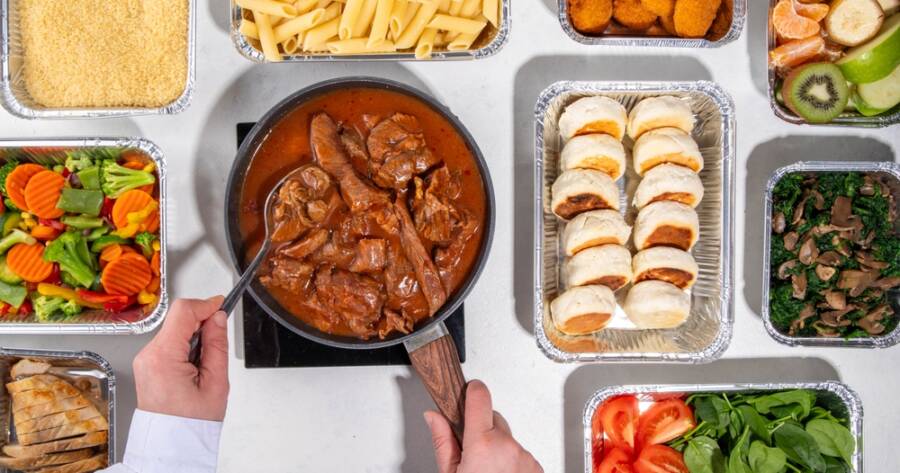Between work, errands, family obligations, and trying to squeeze in a little downtime, cooking from scratch every day can feel impossible. That’s where batch cooking comes in. With just a few hours of prep once or twice a week, you can stock your fridge (and freezer) with ready-to-eat meals that are healthier, more affordable, and way less stressful than ordering takeout night after night.
Whether you’re new to the concept or looking to fine-tune your routine, this guide will walk you through the basics of batch cooking—and how to make it work for your lifestyle.
What Is Batch Cooking?
Batch cooking is the practice of preparing large quantities of food in one go, then dividing it into portions to eat throughout the week (or freeze for later). It can mean cooking full meals—like soups, casseroles, or pasta dishes—or prepping components like grilled chicken, roasted veggies, or grains that can be mixed and matched.
The goal isn’t just to cook in bulk—it’s to plan smart, reduce waste, and save time while still eating nutritious, home-cooked meals.
Why Batch Cooking Works
-
Saves time: Instead of cooking from scratch every night, you spend a few hours once or twice a week and enjoy the payoff for days.
-
Reduces stress: No more last-minute dinner decisions or staring blankly into the fridge at 6 p.m.
-
Cuts costs: Buying ingredients in bulk and using them strategically helps stretch your grocery budget.
-
Supports healthier eating: You control the ingredients, portions, and cooking methods—no added sugar, preservatives, or mystery sauces.
-
Reduces waste: Pre-planned meals make it easier to use what you buy before it spoils.
How to Get Started with Batch Cooking
If you’re new to batch cooking, start small. You don’t have to prepare every meal for the week on your first go. Try focusing on just dinners or a few staple ingredients you can repurpose.
Here’s a simple step-by-step to guide you:
-
Plan your menu
Choose 2–4 meals that share ingredients or can be easily repurposed. For example, roasted chicken can become tacos, salads, or stir-fry. Grains like rice or quinoa pair well with almost anything. -
Make a shopping list
Once your meals are chosen, write a list of everything you’ll need. Stick to whole ingredients and try to buy in bulk where it makes sense (like beans, oats, or frozen vegetables). -
Pick your prep day
Set aside a few hours when you’re free to cook—Sunday afternoon is a popular choice. Clear your kitchen space, gather your containers, and set the mood with music or a podcast. -
Cook in stages
Start with anything that takes the longest—roasting meats, baking casseroles, or cooking grains. While those are cooking, chop vegetables, prep sauces, and assemble other components. -
Store your food smartly
Divide meals into containers based on portions or meal types. Use airtight containers, label them with dates, and store them in the fridge (for meals eaten within 3–5 days) or freezer (for longer-term storage).
Best Foods for Batch Cooking
Some foods hold up better than others when cooked in advance. Here are great choices to include in your batch cooking routine:
-
Proteins: Chicken breast, ground beef or turkey, tofu, beans, lentils, and boiled eggs.
-
Grains and starches: Brown rice, quinoa, couscous, farro, sweet potatoes, and pasta.
-
Vegetables: Roasted carrots, broccoli, bell peppers, green beans, and zucchini reheat well.
-
Sauces and dressings: Pesto, marinara, vinaigrettes, and tahini-based sauces can transform basic meals.
Avoid items that wilt or get soggy fast—like delicate greens or crispy-fried foods—unless you’re eating them right away.
Time-Saving Tips
-
Double recipes: If you’re already cooking something, make twice as much and freeze half.
-
Use sheet pans and slow cookers: These tools allow you to cook big batches with minimal effort.
-
Embrace theme nights: Taco Tuesday, Stir-Fry Friday, or Pasta Night can help simplify planning.
-
Don’t forget breakfast: Overnight oats, breakfast burritos, or egg muffins can save you time in the morning, too.
The Effort Pays Off
Batch cooking might take a little effort upfront, but it pays off with more free time, less food waste, and a fridge full of meals ready to go. With a bit of planning and a few storage containers, you’ll turn your kitchen into a powerhouse of efficiency—and make weeknight dinners easier than ever.

